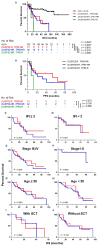DUSP22 rearrangement is associated with a distinctive immunophenotype but not outcome in patients with systemic ALK-negative anaplastic large cell lymphoma
- PMID: 36453104
- PMCID: PMC10230410
- DOI: 10.3324/haematol.2022.281222
DUSP22 rearrangement is associated with a distinctive immunophenotype but not outcome in patients with systemic ALK-negative anaplastic large cell lymphoma
Abstract
DUSP22 rearrangement (R) has been associated with a favorable outcome in systemic ALK-negative anaplastic large cell lymphoma (ALCL). However, a recent study found that patients with DUSP22-R ALK-negative ALCL have a poorer prognosis than was reported initially. In this study, we compared the clinicopathological features and outcomes of patients with ALKnegative ALCL with DUSP22-R (n=22) versus those without DUSP22-R (DUSP22-NR; n=59). Patients with DUSP22-R ALCL were younger than those with DUSP22-NR neoplasms (P=0.049). DUSP22-R ALK-negative ALCL cases were more often positive for CD15, CD8, and less frequently expressed pSTAT3Tyr705, PD-L1, granzyme B and EMA (all P<0.05). TP63 rearrangement (TP63-R) was detected in three of the 66 (5%) ALK-negative ALCL cases tested and none of these cases carried the DUSP22-R. Overall survival of patients with DUSP22-R ALCL was similar to that of the patients with DUSP22-NR neoplasms regardless of International Prognostic Index score, stage, age, or stem cell transplantation status (all P>0.05), but was significantly shorter than that of the patients with ALK-positive ALCL (median overall survival 53 months vs. undefined, P=0.005). Five-year overall survival rates were 40% for patients with DUSP22-R ALCL versus 82% for patients with ALK-positive ALCL. We conclude that DUSP22-R neoplasms represent a distinctive subset of ALK-negative ALCL. However, in this cohort DUSP22-R was not associated with a better clinical outcome. Therefore, we suggest that current treatment guidelines for this subset of ALK-negative ALCL patients should not be modified at present.
Figures






Comment in
-
DUSP22-rearranged ALK-negative anaplastic large cell lymphoma is a pathogenetically distinct disease but can have variable clinical outcome.Haematologica. 2023 Jun 1;108(6):1463-1467. doi: 10.3324/haematol.2022.282025. Haematologica. 2023. PMID: 36453106 Free PMC article. No abstract available.
Similar articles
-
[Detection of chromosomal translocations of DUSP22 and TP63 in ALK-negative anaplastic large cell lymphoma by fluorescence in situ hybridization and related clinical relevance].Zhonghua Bing Li Xue Za Zhi. 2019 Oct 8;48(10):791-795. doi: 10.3760/cma.j.issn.0529-5807.2019.10.008. Zhonghua Bing Li Xue Za Zhi. 2019. PMID: 31594044 Chinese.
-
ALK-negative anaplastic large cell lymphoma with DUSP22 rearrangement has distinctive disease characteristics with better progression-free survival: a LYSA study.Haematologica. 2023 Jun 1;108(6):1590-1603. doi: 10.3324/haematol.2022.281442. Haematologica. 2023. PMID: 36453105 Free PMC article.
-
ALK-negative anaplastic large cell lymphoma is a genetically heterogeneous disease with widely disparate clinical outcomes.Blood. 2014 Aug 28;124(9):1473-80. doi: 10.1182/blood-2014-04-571091. Epub 2014 Jun 3. Blood. 2014. PMID: 24894770 Free PMC article.
-
Systemic ALK-negative anaplastic large cell lymphoma: Insights into morphologic, immunophenotypic, genetic and molecular characteristics.Hum Pathol. 2025 Feb;156:105671. doi: 10.1016/j.humpath.2024.105671. Epub 2024 Oct 17. Hum Pathol. 2025. PMID: 39424106 Review.
-
The biology and management of systemic anaplastic large cell lymphoma.Blood. 2015 Jul 2;126(1):17-25. doi: 10.1182/blood-2014-10-567461. Epub 2015 Apr 13. Blood. 2015. PMID: 25869285 Review.
Cited by
-
Brentuximab vedotin plus chemotherapy for the treatment of front-line systemic anaplastic large cell lymphoma: subgroup analysis of the ECHELON-2 study at 5 years' follow-up.Blood Cancer J. 2025 Aug 1;15(1):129. doi: 10.1038/s41408-025-01329-2. Blood Cancer J. 2025. PMID: 40750774 Free PMC article. Clinical Trial.
-
Nodal Peripheral T-Cell Lymphoma: Therapeutic Challenges and Future Perspectives.Cancers (Basel). 2025 Mar 28;17(7):1134. doi: 10.3390/cancers17071134. Cancers (Basel). 2025. PMID: 40227698 Free PMC article. Review.
-
DUSP22-rearranged ALK-negative anaplastic large cell lymphoma is a pathogenetically distinct disease but can have variable clinical outcome.Haematologica. 2023 Jun 1;108(6):1463-1467. doi: 10.3324/haematol.2022.282025. Haematologica. 2023. PMID: 36453106 Free PMC article. No abstract available.
-
Molecular Insights into the Diagnosis of Anaplastic Large Cell Lymphoma: Beyond Morphology and Immunophenotype.Int J Mol Sci. 2025 Jun 19;26(12):5871. doi: 10.3390/ijms26125871. Int J Mol Sci. 2025. PMID: 40565334 Free PMC article. Review.
-
Introduction to the peripheral T-cell lymphoma review series: advances in molecular characterization, classification refinement and treatment optimization.Haematologica. 2023 Dec 1;108(12):3204-3210. doi: 10.3324/haematol.2023.282719. Haematologica. 2023. PMID: 38037798 Free PMC article. No abstract available.
References
-
- Vose J, Armitage J, Weisenburger D; International T-Cell Lymphoma Project. International peripheral T-cell and natural killer/T-cell lymphoma study: pathology findings and clinical outcomes. J Clin Oncol. 2008;26(25):4124-4130. - PubMed
-
- Falini B, Pileri S, Zinzani PL, et al. . ALK+ lymphoma: clinicopathological findings and outcome. Blood. 1999;93(8):2697-2706. - PubMed
-
- Sibon D, Fournier M, Briere J, et al. . Long-term outcome of adults with systemic anaplastic large-cell lymphoma treated within the Groupe d'Etude des Lymphomes de l'Adulte trials. J Clin Oncol. 2012;30(32):3939-3946. - PubMed
-
- ten Berge RL, de Bruin PC, Oudejans JJ, et al. . ALK-negative anaplastic large-cell lymphoma demonstrates similar poor prognosis to peripheral T-cell lymphoma, unspecified. Histopathology. 2003;43(5):462-469. - PubMed
MeSH terms
Substances
LinkOut - more resources
Full Text Sources
Research Materials

